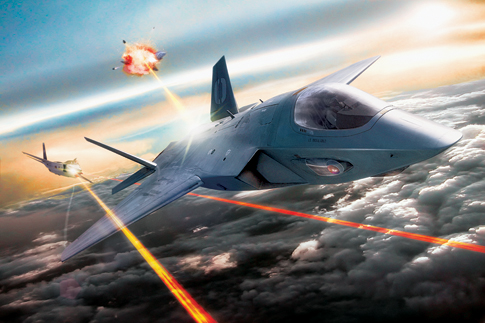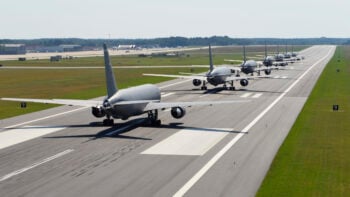
Air Force artwork of a dogfight with lasers.
WASHINGTON: The head of Pentagon research and experimentation cast fresh doubt on plans to equip aircraft with lasers capable with shooting down enemy missiles, suggesting this morning that the physics just don’t add up.
“I’m extremely skeptical that we can put a large laser on an aircraft and use it to shoot down an adversary missile, even from fairly close,” Michael Griffin, undersecretary of defense for research and engineering said on a conference call hosted by the Washington Space Business Roundtable.
Griffin’s remarks could also be seen as taking a jaundiced view of an experimental Air Force program that seeks to shoot down air-to-air and ground-to-air missiles in the next few years.
“I think it can be done as an experiment, but as a weapon system to equip an airplane with the kinds of lasers we think necessary — in terms of their power level, and all their support requirements, getting the airplane to altitudes where atmospheric turbulence can be mitigated appropriately — that combination of things doesn’t go on one platform. So, I’m just extremely skeptical of that.”
Just a year ago, Griffin was extolling the work the Pentagon was doing to get lasers into the field as soon as possible. “More than any other of the areas in my portfolio, I think the leverage of directed energy is so high … that it is right at the top of my investment priorities,” he said in March last year.
“My principal goal for directed energy actually is to have it stop being ‘the technology of the future and already will be’ and move it into the fleet, move it into the field,” Griffin said. At the time he said he hoped to have operational systems at the tens or low hundreds of kilowatts level on DoD platforms undergoing more rigorous testing.
His comments this morning don’t signal the Pentagon is walking away from developing families of powerful lasers. It was also clear from his remarks that DoD remains committed to investing in research on fiber lasers, diode pumped alkali lasers and slab lasers.
“These are at technology levels where they are variously capable of output power in the several tens of kilowatts to low hundreds of kilowatts range,” he said, recalling his remarks last year. “That’s getting big enough to be worthy of consideration as a weapon in certain applications. We have for budgetary reasons had to cut back on some of our laser scaling efforts,” he explained, “but we’re certainly not giving up on directed energy.”
Griffin has been a believer in laser research for decades, going back to his work over 30 years ago as part of President Reagan’s Strategic Defense Initiative, dubbed “Star Wars” for its emphasis on orbiting anti-missile lasers that proved beyond the technology of the time.
But despite his dour outlook on putting some of these lasers on aircraft, he remains interested in putting them in space.
“We’re not investing in airborne platforms for shooting down evolutionary missiles. We do think there are applications for space platforms that could well be quite productive,” he said.
The Air Force Research Lab is doing its own work on airborne lasers, however, including the $155 million Self-protect High Energy Laser Demonstrator (SHiELD) effort, which currently only lives as a ground-based demonstrator. The service wants to shrink SHiELD down to a pod for testing on an F-15 by 2021 and eventually put it on F-16 and F-35 single-engine fighters.
Army inching towards late FY25 Chinook Block II full-rate production contract
Boeing recently announced the Block II helo’s first maiden flight and plans to deliver the first production aircraft to the service in the coming weeks.


























